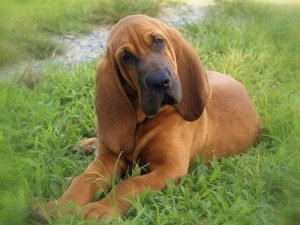The History Of The Bloodhound

The Bloodhound was first bred around 1000 A.D. by monks at a monastery in Belgium. From 1200 A.D., the monks of the Abbey of St. Hubert annually sent several pairs of these hounds to the King of France as gifts. These were not always thought of as royal hounds, and it was not until the 1550s when Henry IV presented a pack of hounds to James I of England that they became popular with the royal set.
Breed Description
The Bloodhound is a massive, very powerful hound dog. The back is very strong in relation to its size. The head is long and narrow. The muzzle is long and the nose is black. Their deep set eyes are diamond in shape due to the lower lids being dragged down by the heavy upper lids. Eye color varies from deep hazel to yellow. Ears are thin, soft long and droop low. They have extra wrinkled skin hanging around the head and neck, where it hangs in deep folds. The tail is high with a slight curve. The extra folds of skin around the head and neck aid them in holding in scent particles while tracking. The coat is wrinkled, short and hard in texture. Hair on the ears and skull is softer. Coat colors include black and tan, liver and tan, red and tawny, and red. Some have white on the chest, feet and tail tip. Bloodhounds weight 90 to 110 pounds and stand 20 to 26 inches tall. They can live 10 to 12 years. The average litter size is 8 to 10 pups.
Personality & Care
An ideal companion for a Bloodhound would be singles, families and active folks. Bloodhounds will do well in an apartment if they receive sufficient exercise. They are relatively inactive indoors, and will do best with an average sized yard in which to play. These hounds need to have a long daily walk. If they find an interesting scent, it may be difficult to get their attention away from it. They have amazing stamina and can walk for hours. They love to hike, but, again, they may get the urge to investigate an interesting scent. It is recommended not to overtire these canines until they are adults.
Bloodhounds are kind, patient, mild-mannered, and lovable additions to any home. They are excellent with children and are so good-natured, they will lie there and have been known to allow a child to climb all over them – still it’s best to monitor kids around any pet.
Photo: Courtesy of Gilliamhome’s Olympus E3 and Evolt 500 via Flickr (CC by 2.0)









